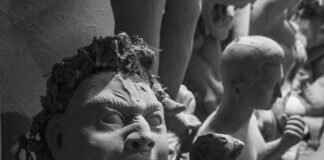Imagine the weight of the world on your shoulders, literally. Simon of Cyrene is a figure whose story resonates deeply with themes of sacrifice and courage. But who exactly was this enigmatic man? How did he come to bear the cross of Jesus during the most pivotal moment in history? Exploring Simon of Cyrene’s role in the Crucifixion can unveil profound insights into compassion, duty, and the human experience. Many people often wonder why Simon was chosen for this heavy task. Was it mere coincidence, or was there a greater purpose behind his involvement? As we delve into the historical significance of Simon of Cyrene, we uncover not just a biblical narrative, but a powerful lesson in selflessness and resilience. His brief yet impactful appearance in the Gospels invites us to consider the ways we can bear each other’s burdens in our own lives. Discover how Simon of Cyrene’s story continues to inspire countless individuals today, encouraging us to reflect on our own capacity for empathy and support. Join us on this journey to understand why Simon’s legacy endures and how it relates to modern challenges we face in our communities.
The Journey of Simon of Cyrene: Uncovering the Man Who Carried the Cross for Christ
Simon of Cyrene is a figure that often gets overlooked in discussions about the biblical narrative surrounding the crucifixion of Jesus Christ. His mention in the Gospels brings a intriguing glimpse into the events that unfolded during this pivotal moment in history. If you ever wonder who Simon of Cyrene was, you’re not alone! Many people do not know much about him, yet his role is quite significant, even if it is brief.
Who Was Simon of Cyrene?
Simon of Cyrene was a man from North Africa, specifically from a city called Cyrene, which is in modern-day Libya. He is most noted for carrying the cross of Jesus on the way to the crucifixion site. This event is described in the Synoptic Gospels: Matthew, Mark, and Luke, but not in John. His inclusion in these texts raises some fascinating questions.
- Background:
- Simon was likely a Jewish man who traveled to Jerusalem for Passover.
- Cyrene was known for its large Jewish population, making Simon’s presence in Jerusalem plausible.
The Biblical Account
The story of Simon of Cyrene is told in different ways across the Gospels. Here’s a quick comparison of how each Gospel portrays this moment:
- Matthew 27:32: Simon is simply mentioned as the man who was compelled to carry Jesus’ cross.
- Mark 15:21: This Gospel provides a bit more detail, stating that Simon was the father of Alexander and Rufus, which might indicate he was known to the early Christian community.
- Luke 23:26: Like Mark, it mentions Simon carrying the cross but does not elaborate on his identity.
Why Simon Was Important
Simon’s role in the crucifixion narrative shows various themes, including sacrifice, duty, and unexpected roles in history. Some key points about his significance are:
- Symbol of Suffering: Carrying the cross illustrates the burden of suffering and the weight of sin.
- Involuntary Participation: Simon didn’t choose to help Jesus; he was forced into it, reflecting how sometimes people are called to take on burdens they didn’t ask for.
- Legacy: His sons, Alexander and Rufus, might have continued in the faith, suggesting that Simon’s actions had a lasting impact.
Historical Context of Cyrene
Cyrene had a rich history and was a hub for Jewish culture. A few aspects of its context are:
- Location: It was located in North Africa, making its citizens diverse.
- Jewish Diaspora: Many Jews lived there due to the diaspora, which spread Jewish communities throughout the Mediterranean.
- Cultural Exchange: Cyrene was influenced by Greek and Roman cultures, which shaped its society.
Modern Interpretations
Today, Simon of Cyrene is often seen as a figure that represents everyone who carries a burden or helps others in their time of need. Some modern interpretations include:
- Art and Literature: Simon is featured in various artistic works that highlight his role during the crucifixion.
- Theological Insights: Scholars discuss his importance in understanding Jesus’ suffering and the call to take up one’s cross.
- Personal Reflection: Many believers see Simon as a model for selfless service and humility.
Takeaways About Simon of Cyrene
Here’s a list of takeaways that summarize Simon’s role and significance:
- Simon’s act was a moment of compassion amidst cruelty.
- His story encourages self-reflection on how we assist others in their struggles.
- The legacy of Simon may inspire people to recognize the importance of bearing one another’s burdens.
Conclusion Thoughts
In examining Simon of Cyrene, we find a rich tapestry of historical, cultural, and spiritual significance. He is a reminder of how even those who seem to play a minor role can have a lasting impact. Whether through suffering, service, or simply being present, Simon exemplifies the unexpected paths that lead to meaningful engagement with others. His story challenges us to think about our own lives and how we might be called to support those around us in their hardest moments.
5 Fascinating Facts About Simon of Cyrene: The Unsung Hero of the Crucifixion Story
Simon of Cyrene is a figure that many people might not know about, but his story is quite significant in the context of the New Testament. He is often remembered as the man who helped Jesus carry the cross on the way to crucifixion. This act, though brief in the biblical narrative, holds a lot of weight in Christian teachings, and it brings up themes of sacrifice, service, and the sharing of burdens.
Who Was Simon of Cyrene?
Simon was from Cyrene, a city in North Africa, which is present-day Libya. He was likely an African Jew who traveled to Jerusalem. The Gospels mention him, mainly in the context of the Passion of Christ. Here’s what we generally know about him:
- Origins: He came from Cyrene, which was known for its large Jewish community.
- Family: The Gospels mention that he had two sons, Alexander and Rufus, which suggest he was known in the early Christian community.
- Encounter with Jesus: Simon was compelled to carry the cross for Jesus, who was too weak to do it himself.
Historical Context
The event of Simon carrying the cross is described in the Synoptic Gospels (Matthew, Mark, and Luke). It happens during the final hours leading up to Jesus’ crucifixion. Here’s how it fits into the larger narrative of the time:
- Roman Authority: The Romans were in control of Jerusalem, and they had a reputation for brutal enforcement of their laws. It was common for them to make an example of criminals.
- Jewish Passover: Jesus’ trial and crucifixion occurred during Passover, a time when Jerusalem was crowded with pilgrims. This makes Simon’s involvement more significant, as many people were present to witness the events.
The Biblical Narrative
In the Gospels, Simon’s story is mentioned in several passages:
- Mark 15:21: “And they compelled a passerby, Simon of Cyrene, who was coming in from the country, the father of Alexander and Rufus, to carry his cross.”
- Matthew 27:32: “As they went out, they found a man of Cyrene, Simon by name. They compelled this man to carry his cross.”
- Luke 23:26: “And as they led him away, they seized one Simon of Cyrene, who was coming in from the country, and laid on him the cross, to carry it behind Jesus.”
These passages highlight how Simon was involuntarily drawn into the narrative of Jesus’ suffering.
Significance of Simon’s Role
The role of Simon is often interpreted in various ways. Here are some of the notable interpretations:
- Symbol of Assistance: His act of carrying the cross symbolizes helping others through their burdens. This resonates deeply in Christian teachings about love and service.
- Diversity in the Early Church: As a North African, Simon represents the diversity of the early Christian community, showing that the message of Jesus transcended ethnic and geographical boundaries.
- Legacy: The mention of his sons, Alexander and Rufus, in the Gospels indicates that Simon might have been a prominent figure in the early church, perhaps even influencing the spread of Christianity.
Comparisons and Cultural Impact
Simon’s story can be compared to other figures who have helped Jesus or have been instrumental in the Gospel narratives. For instance:
- Mary, Mother of Jesus: She also bore a significant burden during Jesus’ life and ministry.
- Joseph of Arimathea: Another figure who, like Simon, contributed to Jesus’ story by providing a tomb for his burial.
Practical Examples of Carrying Burdens
In modern life, the act of carrying burdens can take many forms. Here are some practical ways people can embody Simon’s legacy:
- Volunteering: Helping at shelters, food banks, or community centers.
- Emotional Support: Being there for friends or family in times of distress.
- Advocacy: Standing up for those who are marginalized or oppressed.
Reflection on Simon’s Impact
Simon of Cyrene might seem like a minor character in the grand narrative of the New Testament, but his role resonates through the ages. His willingness to carry the cross serves as a powerful reminder of compassion and solidarity. In a world where burdens can feel heavy, embracing the call to help others can make a significant difference.
The story of Simon encourages us to reflect on our own lives and how we can offer support to those around us. Whether it’s a small act of kindness or a larger commitment to service, following Simon’s example can lead to meaningful change.
Why Simon of Cyrene’s Role in the Passion Narrative Matters: A Deep Dive into His Impact
Simon of Cyrene is a figure well known in Christian tradition, but many people do not know much about him beyond the brief mention in the Gospels. He has a story that relates to the crucifixion of Jesus, and it’s filled with historical significance and even some mystery. This article will explore Simon’s role in the Passion narratives, the historical context of Cyrene, and the impact Simon has on Christian thought.
Who Was Simon of Cyrene?
Simon of Cyrene is mentioned in three of the four Gospels. His most notable mention comes during the events leading up to the crucifixion of Jesus. The Gospels of Mark, Matthew, and Luke describe Simon as a man who was compelled by Roman soldiers to carry the cross for Jesus.
- Mark 15:21: “And they forced a passerby, Simon of Cyrene, who was coming in from the country, the father of Alexander and Rufus, to carry his cross.”
- Matthew 27:32: “As they went out, they found a man of Cyrene, Simon by name. They compelled this man to carry his cross.”
- Luke 23:26: “And as they led him away, they seized one Simon of Cyrene, who was coming in from the country, and laid on him the cross, to carry it behind Jesus.”
Simon was coming from the countryside, likely on his way into Jerusalem, when he was forced into this role. It’s interesting to note that he was described not just as Simon but also as the father of Alexander and Rufus. This detail has led many scholars to speculate that these two sons might have been known to the early Christian community.
Historical Context of Cyrene
Cyrene was a city located in present-day Libya, and it was known for its large Jewish population during the time of Jesus. The city had a history that dated back to the Greeks and later became a part of the Roman Empire. It was a significant center for trade and culture.
- Key Historical Points:
- Cyrene was founded in the 7th century B.C. by Greek colonists.
- It became a thriving hub with schools of philosophy and a rich cultural life.
- The Jewish community in Cyrene was prominent, and many Jews migrated from there to other parts of the Roman Empire.
Given the diverse population of Cyrene, it’s not surprising that Simon might have been in Jerusalem for a religious festival, perhaps Passover, which was a time when many Jews traveled to the city.
Simon’s Role in the Passion Narrative
Simon’s role is a significant moment in the Passion narrative. Jesus, who had been beaten and weakened, needed someone to help him carry the cross. This moment signifies not just a physical act but also a deeper spiritual message. Simon’s unwillingness, or perhaps his lack of choice in the matter, highlights the burden of the cross.
- Symbolism:
- Burden Bearing: Simon’s act can be seen as an allegory for the Christian duty of bearing one’s cross.
- Unexpected Discipleship: Simon wasn’t a disciple by choice, yet he became part of the story of salvation. This has led some theologians to think about the nature of discipleship itself.
- Inclusion of Gentiles: Simon’s background as a foreigner can be interpreted as a foreshadowing of the message of Jesus reaching beyond the Jewish community.
Theological Implications
Simon’s encounter with Jesus raises several theological questions. Was Simon aware of who Jesus was? Did he understand the significance of his action? These questions have led to various interpretations within Christian thought.
- Possible Interpretations:
- An Act of Grace: Some suggest that Simon’s unexpected role was an act of divine grace.
- A Call to Action: Others see it as a call for all believers to take up their crosses and follow Jesus, even when it’s not convenient.
Cultural Impact
The story of Simon of Cyrene has influenced various aspects of Christian culture, from art to literature. His name appears in works about compassion and sacrifice.
- Notable Mentions:
- In art, Simon is often depicted carrying the cross alongside Jesus, emphasizing his role in the story.
- Literature has also explored themes of unexpected discipleship, using Simon as a metaphor.
The tale of Simon of Cyrene remains a poignant reminder of how unexpected encounters can shape history and personal faith journeys. His brief mention in the Gospels opens a window into discussions about burden, grace, and what it means to follow. Whether as a historical figure or a symbol, Simon’s legacy continues to inspire discussions about faith, sacrifice, and the often-unexpected paths of discipleship.
Exploring the Legacy of Simon of Cyrene: What His Story Teaches Us Today
Simon of Cyrene is a name that echoes through history, often associated with one of the most poignant moments in the Christian narrative. He is known for his role in helping Jesus carry the cross, a moment which has been interpreted in many ways over the centuries. It raises questions about duty, sacrifice, and the unexpected paths that intertwine our lives with those of others.
Who Was Simon of Cyrene?
So, who exactly was Simon of Cyrene? Well, he was a man from Cyrene, which is a region in present-day Libya, located in North Africa. The Gospels of Matthew, Mark, and Luke mention him, but not much detail is provided about his life before this significant event. He is described as the father of Alexander and Rufus, which suggest that he was a family man.
- Key Points about Simon:
- Originated from Cyrene, North Africa.
- Mentioned in the New Testament, primarily in Mark 15:21, Matthew 27:32, and Luke 23:26.
- Father of Alexander and Rufus, indicating he had a family.
The Crucifixion and Simon’s Role
In the story of the crucifixion, Jesus was forced to carry his cross to Golgotha, the site of his execution. However, he was so weakened by the beatings and tortures he had endured that he could not carry it any longer. Roman soldiers then compelled Simon to carry the cross for him. This moment, while brief, is filled with deep meaning.
- Context of the Crucifixion:
- Jesus was arrested, tried, and condemned by the Roman authorities.
- The journey to Golgotha was a public spectacle, meant to humiliate and punish.
- Simon’s act of carrying the cross is seen as a moment of compassion amidst suffering.
Interpretations and Significance
The act of Simon carrying the cross has been interpreted in various ways throughout Christian history. Some see it as a symbol of discipleship and sacrifice. Others interpret it as a reminder of the burdens we all carry. It also highlights the theme of unexpected service—how a passerby became part of a pivotal moment in religious history.
- Different Interpretations:
- Discipleship: Simon’s act is seen as an example of following Jesus, even in difficult times.
- Compassion: It reflects the need to help others, especially when they are in pain or distress.
- Unexpected Roles: Simon, initially a bystander, played a significant role in a world-changing event.
The Legacy of Simon of Cyrene
Simon of Cyrene’s legacy extends beyond the biblical text. His brief appearance has inspired countless discussions, artworks, and even songs. Churches often reference him in sermons about sacrifice and service.
- Cultural References:
- Art: Many paintings depict Simon helping Jesus, showcasing the emotional weight of the moment.
- Literature: Writers have referenced Simon’s story as a metaphor for carrying one’s cross in life.
- Songs: Various hymns and spirituals draw on Simon’s experience, emphasizing themes of burden and aid.
Comparisons with Other Figures
In religious texts, Simon of Cyrene can be compared to other figures who have helped carry burdens for others. For example, in the Old Testament, figures like Moses and Aaron helped bear the burdens of their people.
- Comparison Table:
| Name | Role | Context |
|---|---|---|
| Simon of Cyrene | Helped Jesus carry the cross | New Testament, Crucifixion |
| Moses | Led Israelites out of Egypt | Old Testament, Exodus |
| Aaron | Spoke for Moses | Old Testament, Exodus |
Practical Takeaways
So, what can we learn from Simon of Cyrene’s story? His life reminds us to be open to helping others, even when we do not expect to be called into service. Here are a few practical takeaways:
- Help Others: You never know when your small act of kindness can change someone’s life.
- Embrace the Unexpected: Sometimes, life’s most significant moments come from unplanned experiences.
- Carry Your Cross: Everyone faces struggles; it’s important to support each other in these times.
Simon of Cyrene’s story may be short, but it’s rich with meaning. His legacy teaches us about compassion, duty, and the impact we can have on others, even in the most unexpected ways. Through the lens of history, his act of carrying the cross remains a powerful symbol of shared burdens and the grace we can offer one another.
Who Was Simon of Cyrene? Discover the Historical and Spiritual Significance of His Encounter with Jesus
Simon of Cyrene is a figure that often comes up in discussions about the Passion of Christ, but not many people fully understands who he is and the significance of his story. He is mentioned in the New Testament, specifically in the Gospels, as the man who was compelled to carry the cross for Jesus during the crucifixion. His story, while brief, holds deep meaning for many believers and historians alike.
Who was Simon of Cyrene?
Simon of Cyrene was from a place called Cyrene, which is in modern-day Libya. He is mentioned in the Gospels of Matthew, Mark, and Luke. His story differ slightly in each account, but they all share the core element of him carrying the cross. It’s interesting to note that he likely was in Jerusalem for the Passover, which was a common reason for many Jews to travel there, and so he probably hadn’t planned to be part of such a significant event.
- Name: Simon
- Origin: Cyrene (modern-day Libya)
- Role: Carried Jesus’ cross
- Gospel References: Matthew 27:32, Mark 15:21, Luke 23:26
The Cross Carrying Incident
The Gospels describes Simon being forced by Roman soldiers to carry the cross of Jesus. As Jesus was weak from the scourging and the weight of the cross, the soldiers looked for someone to help. Simon was in the wrong place at the wrong time, but this moment would go on to define him throughout history. It’s believed that he was just a passerby, someone who didn’t expect to be part of such a monumental event.
- Context: Jesus was on his way to Golgotha, the place of his crucifixion.
- Significance: This act has been interpreted as a symbol of sharing in Jesus’ suffering.
Theological Implications
Simon of Cyrene’s act of carrying the cross is often seen as a representation of discipleship. In Christianity, taking up one’s cross is a metaphor for following Jesus and sharing in his sufferings. This has led many theologians to discuss the implications of Simon’s actions.
- Discipleship: It signifies the call to follow Christ, even when it involves suffering.
- Suffering: Simon’s bearing the cross can symbolize the burdens that Christians take upon themselves.
Historical Context
Simon’s story happens in a very specific historical context. The Roman Empire controlled Jerusalem at this time, and the crucifixion was a common method of execution for criminals. The act of forcing someone to carry a cross was also a way to humiliate the condemned, making Simon’s involvement even more poignant.
- Roman Practices: Crucifixion was used to deter others from committing crimes.
- Cultural Significance: Carrying the cross was seen as a public disgrace.
Simon’s Legacy
Interestingly, after this event, Simon of Cyrene fades into obscurity. However, the early church held his story in some esteem. Some traditions suggest that he became a follower of Jesus after the event. His sons, Alexander and Rufus, are also mentioned in Mark 15:21, suggesting that his family may have been significant in the early Christian community.
- Legacy Points:
- Possible conversion to Christianity
- Sons mentioned in the Gospel, indicating a continued lineage in the faith
Comparisons with Other Figures
When you think about Simon of Cyrene, it can be useful to compare him with other biblical figures who demonstrated similar themes of suffering and service.
- Moses: Also chosen to lead others, despite his initial reluctance.
- Peter: Denied Christ but later became a foundational figure in Christianity.
Practical Examples
In modern Christian practice, Simon of Cyrene is often used as an example of selfless service. Churches sometimes use his story to encourage members to support one another through difficult times, highlighting the community aspect of faith.
- Service: Helping others carry their burdens.
- Compassion: Being present for those in suffering.
Simon of Cyrene’s brief yet impactful story reminds us of the unexpected ways we can find ourselves involved in a greater purpose. His legacy, while not well-known, continues to inspire many to take up their own crosses, to share in the burdens of others, and to embrace the call of discipleship in their own lives. Through the lens of Simon’s encounter with Jesus, we see a reflection of our own journeys and the ways we can step in to help others in their time of need.
Conclusion
In conclusion, Simon of Cyrene stands as a profound figure in the narrative of the Crucifixion, symbolizing the unexpected roles individuals can play in pivotal moments of history. His act of carrying the cross for Jesus not only highlights the themes of compassion and sacrifice but also serves as a reminder of the importance of supporting others in their times of struggle. Throughout this discussion, we explored Simon’s background, the significance of his actions, and the lessons we can draw from his story about community and empathy. As we reflect on Simon’s experience, let us consider how we can be more like him in our own lives—willing to lend a hand to those who are burdened and to engage in acts of kindness without seeking recognition. May we all strive to embody the spirit of Simon, making a difference in our communities through our simple yet powerful actions.














